The apostolic journey takes place between July 24 and 30, following the discovery of mass graves with hundreds of unidentified bodies at former church-run residential schools in Canada.
The first graves were discovered in May 2021, on the grounds of a former school in Kamloops, in the western province of British Columbia, exposing the unhealed wounds of the forced Christianization of Indigenous Canadians.
“We want the truth about what happened in residential schools to be shared with the public. Everyone needs to know what happened to us,” Randy Ermineskin, chief of the Ermineskin Cree tribe, said at a joint briefing with other Indian leaders in Edmonton, part of the Pope’s visit. .
“Justice needs to be served. There needs to be an opportunity to redress wrongdoing,” said George Arcand Jr., a First Nations confederation representative.
According to him, the apology presented by Jorge Bergoglio in April is a “step forward” in the indigenous search for reparation. “But it doesn’t stop there, there is still a lot to do.
This is just the beginning,” he added.
The so-called boarding schools were intended to “educate” the natives according to Catholic precepts, but for this they forcibly removed children from their communities and forced them to abandon their customs and language.
In addition, students were frequently victims of sexual and physical abuse by teachers. It is estimated that around 150,000 natives went through these boarding schools until the 1970s. One of these schools, in Maskwacis, will be visited by the Pope.
“As a survivor, I know it will be painful. Remembering the hallways, the rooms, the way we were treated, is painful,” Randy Ermineskin said.
Indigenous Canadians are also demanding that the Vatican reimburse items such as fur gloves, decorated moccasins and even a rare kayak that two centuries ago was used to navigate the icy waters of the Mackenzie River in the north of the country.
Many of these objects were sent to Rome for a missionary exhibition organized by Pope Pius XI in 1925, whose gallery served as the basis for the Anima Mundi Ethnological Museum, now part of the Vatican Museums. “We need to sit down with the Church to talk about repatriation [dos itens]Sagkeeng First Nation’s Phil Fontaine told the Hyperallergic website.
Itinerary – Francisco arrives in Edmonton, Alberta on July 24 and the next day visits the community of Maskwacis, where he meets with representatives of First Nations, Métis and Inuit peoples.
Already on July 26, the Catholic leader celebrated a mass in an Edmonton stadium and took part in a pilgrimage to Lac Sainte-Anne for Saint-Anne. On the 27th, the pontiff left for Quebec, capital of the French-speaking region of Canada, and met the political, civil, indigenous and diplomatic authorities.
On July 28, François celebrates a mass at the National Shrine of Sainte-Anne-de-Beaupré and then participates in vespers with bishops, priests and other Catholic representatives.
On July 29, the pope holds a private meeting with members of the Society of Jesus and meets with a delegation of natives present in Quebec.
In the afternoon, Bergoglio travels to Iqaluit, the capital and only municipality of the territory of Nunavut, the largest region of the country in geographical extension and also the northernmost, with a good part of its area located in the polar circle. Arctic.
The population of Iqaluit is mainly made up of Inuit (56%), Eskimos who live in the Arctic regions. In town, François meets privately with former students of former Catholic boarding schools and then participates in a meeting with young and old.
“I am about to make a penitential pilgrimage and I hope that, with the grace of God, I can contribute to the path of healing and reconciliation already traveled,” Bergoglio said in his Angelus last Sunday (17). (ANSA).

“Prone to fits of apathy. Beer evangelist. Incurable coffeeaholic. Internet expert.”







